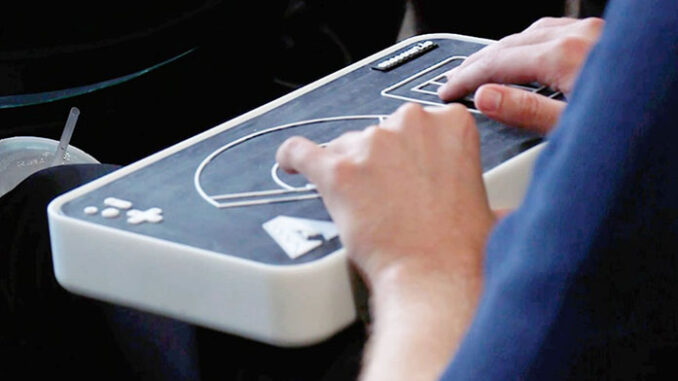
In the heart of Arizona’s monsoon season, a dense, saturated air threatens to swell to full-on precipitation during the first leg of a recent three-game series between the Houston Astros and Arizona Diamondbacks at Chase Field.
The intense mixture of dry and wet air often results in an increased risk of thunderstorms littered with awe inspiring streaks of lightning. Encompassing bursts of desert dirt can make visibility for Arizonans extremely low and difficult to navigate.
Below the covered roof of Chase Field, visibility challenges are also being addressed, but this time for a community that experiences the game differently from most: the blind and vision impaired. Enter OneCourt, which offers a device at Diamondbacks games that translates live gameplay data into trackable vibrations and audio bites.
Arizona State student Adonis Watt – who was diagnosed with congenital glaucoma when he was 5 – sat in the upper-end of section 133 soaking in each crack of the bat and each seemingly compulsory boo of Astros left fielder Jose Altuve when he stepped to the plate.
“It’s like you’re really watching a game for real,” Watt said.
Congenital glaucoma is caused by abnormalities in the development of the eye’s drainage system, which can lead to increased pressure in the eye and damage to the optic nerve – and blindness. From the ages of 5-7, Watt had 12 bilateral eye surgeries to relieve the pressure on his eyes.
Through his condition, and his love for sports, Watt has embraced experiencing sporting events in ways that most others had never had to worry about. But on this Monday night, Watt took in the game unlike any way he had before – through his fingertips.
On July 10, the Diamondbacks announced that they were the first MLB team to adopt OneCourt’s technology in their ballpark. As of June 13th, five devices had already been made available at no additional charge to fans on a first-come, first-serve basis.
In the past year, the device has begun to make its presence felt among professional sports teams and leagues. In January 2025, the Portland Trailblazers became the first professional team to offer the device to fans at all of their home games. Four NBA teams followed suit for the remainder of the 2024-25 NBA season.
“We saw that it was proven technology that worked in the NBA,” said Taylor Merwin, Diamondbacks community relations and partner programs coordinator. “We know that this technology is going to be adopted (across the MLB) so we thought, ‘Why not be the first to adopt it?’ It’s not often you get the chance to be pioneers and be the first in something. We are proud to be the first to adopt this technology.”
The OneCourt team now has partnerships with six professional teams across the NBA and MLB, including the Phoenix Suns and Diamondbacks.
In June, the company secured a partnership with Seattle FWC26 to bring the device to FIFA Club World Cup matches at Lumen Field.
A small start-up organization, the concept for OneCourt was born in Seattle – from a then junior student in 2021 at the University of Washington who came across a video of a blind man at a soccer match “watching” the game with the help of a tactile game board reflecting the play on the field.
That student, Jerred Mace, now the CEO of OneCourt, saw an opportunity to bring something meaningful to a community whose needs are oftentimes discarded in favor of others, especially when it comes to sports.
This perspective was developed through the added experience of having grown up with impaired vision. Multiple eye surgeries were needed to repair astigmatism in his left eye that left him struggling to see beyond 20 feet in front of him.
“I think sighted people tend to take for granted the other senses and other sensory experiences that we have access to,” Mace said. “To see (the video) of this very creative and very personal interaction of someone just helping someone else enjoy the game – it was powerful and we’ve reflected a lot on what that story means to us (as a company).”
Mace, who graduated from Washington with a focus in Industrial Leadership and Entrepreneurship, tried for six months to get his idea off the ground alone.
It was not until he enlisted the help of a team of fellow Washington students that the device started to progress into the form it is today, Mace said. The young eight-person OneCourt team consists of all current or former students from Washington.
The team in just a few short years has made substantial progress in breaking into the sports industry – from an initial prototype that was pieced together with plywood, a few wires and vibration motors to a tablet-sized device with real-time haptic feedback and audio that can be customized to tailor any sport.
For a device that has been adapted to sports such as basketball, baseball, football and now soccer, the basic principles of its functionality remain practically the same.
Real-time haptic feedback utilizes live gameplay data courtesy of major sport league databases and represents the movement or placement of a ball or individual within a game. At the Diamondbacks game, Watt could feel when the baseball was pitched from the mound, where the ball ended up (in the strikezone, outfield or outside the ballpark) and if a run was scored at home plate.
He could even track runners as they moved from one base to the other.
Max Ashton, from the Foundation for Blind Children, became one of the first to use the device and lauded the amount of information and detail the device gives low visibility individuals.
“We had people say that they never got into sports because they can never follow it,” Ashton said. “Being able to feel where the ball is going, where the players are – it really brings you more into the actual game.”
On the surface of the device, elevated lines portray the dimensions of the baseball diamond – each base, foul line, and part of the outfield accounted for. To the right, to further enhance the experience, a similarly elevated representation of the strike zone sits to keep track of where the ball lands with each subsequent pitch.
With an audio port transcribing the game action to the user as it happens, the context of a game is clear and understandable for someone with low vision – with very little delay.
Sometimes even outpacing those who can see the game.
Watt detailed how at one point in the third inning, the generative commentary on the device relayed the score of the game and the play that led to the score in rapid succession. Arguably more impressive, it was able to inform Watt who was next up in the batting order – seconds before the rest of the Chase Field crowd discovered the same piece of information from the public address announcer.
While many blind and low vision fans who have experienced the device have been receptive to the new experience that it is offering them, there are improvements that can still be made for this version of the device.
Connectivity issues within a certain sports venue can sometimes hamper the functionality of the device, but Mace says closely working with T-Mobile to enhance cellular capabilities and improving the efficacy of their own Wi-Fi chip has been paramount.
Additionally, Mace says they are still learning about how the haptic feedback system can be expanded upon within a game.
“Haptics right now has been great for attracting big details – like tracking where the ball is, “ Mace said. “But I think there’s a lot more we can do to convey different things through the vibrations alone that will just further enhance the experience.”
Besides enhancing just the haptic, tactical experience, OneCourt is examining how the audio component can be upgraded. Alexa Garay – who specializes in partnerships and go-to-market strategy for OneCourt, says the company has actively been working on finding a way to implement the voice of radio broadcasters into the device so that users can have the option to listen to that rather than the generative commentary voice.
OneCourt also plans to have an at-home version of the device available to fans in late 2026. Pre-orders for the device can be placed on their website starting in early 2026.
OneCourt is also working to sync their device with visual broadcasts, so that low vision users can enjoy sports without having to leave the comfort of their home if they so desire.
The company’s vision in the marketplace is unlimited, and Garay says a potential use for it could evolve to be used outside of sports – perhaps in education and STEM programs with blind and low vision people remaining as the beneficiaries.
“We plan to go wherever there is data,” Mace said.
Mace notes that gaming is his favorite potential use case for the compatibility of the OneCourt device going forward.
While the possibilities are plentiful, right now, extending its brand in the sports industry is the biggest priority.
With an ultimate desire to scale up production to the point that the device is accessible to all major sports organizations, Garay claims they are prioritizing those who align with the company’s mission and values.
“We are just trying to make sure that all the teams and partnerships we work with end up maintaining the quality of activation that we desire,” Garay said. “And that the product is the same quality we’ve been putting out because that’s the experience we want the fans to have.”
Thus far, the quality of the OneCourt product has not been an issue for those that have had the opportunity to use it.
In fact, they seem excited to see what the future of the device holds – for their own experience and others as it becomes more available in major sports leagues.
“I think as time goes on, it’s just going to get better and better,” Ashton said. “Both in more precise vibrations, vibration motors throughout the machine, quicker response time, better Wi-Fi signals in stadiums.”
Watt is appreciative of OneCourt’s effort.
“Every sport should follow suit,” he said.

hey – drive the highway – tune into what ever game you can get on the radio – listen to the play by play – your the blind game watcher. That – ‘play by play’ is what made the ‘game caller’ amazing! and the game on this radio special! does it take a thing ah mahjig to improve on that? I’m not blind.. if it’s good for them – it’s good for them.. I like the highway game call – but I’m old school. Not even that great a BB fan – but a game on the radio is special is it not…. two outs man on third – count is 3 and 2 – its the 9th inning – playoff’s are on the line! and the ball is HIT! Its long!!!! Fielder is on the wall reaching!!!! He’s ….. game over 🙂
1234567890987654321qwertyuioplkjhgfdsawaertyuio